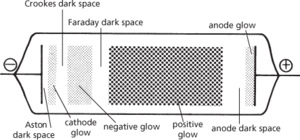A gas-filled tube in which the presence of gaseous molecules contributes significantly to the characteristics of the tube. Normally a gas is a poor electrical conductor but a sufficiently high electric field causes ionization of molecules and atoms in the immediate vicinity of the electrodes; these gaseous ions are attracted to the charged electrodes and a small current – the preconducting current – flows.
If a sufficiently high potential difference is applied to the tube gas breakdown occurs and a large current flows across the tube. The potential difference across the tube drops to a relatively small value and the discharge is self-sustaining. The threshold current is the value of current at which the discharge becomes self-sustaining; the process of establishing the discharge is termed firing. The minimum voltage required for the discharge to continue is the maintaining voltage.
Current flows as a result of a multiple collision of ions within the tube: collisions between ions cause excitation and further ionizations, light being produced when excited atoms and ions return to the ground state. Recombination between positive and negative ions also results in a small amount of light emission.
The phenomena observed depend on the pressure of gas in the tube. At pressures near atmospheric pressure a spark passes between the electrodes. If the pressure is reduced, glow discharge occurs. At relatively high pressures the mean free path of ions is small; a positive glow is observed near the anode and a negative glow near the cathode, the centre of the tube being dark. At lower gas pressures the mean free path increases and the positive glow extends across the tube until the whole tube is filled. The colour of the glow discharge is brilliant and characteristic of the gas in the tube. Glow-discharge tubes can be used for luminous signs and for lighting purposes.
A further reduction in pressure causes a change in the glow pattern (see diagram). Additional dark regions appear in which electrons, produced by ionization and excitation, have insufficient energy for excitation and the probability of recombination is low. The largest potential drop in the tube is across the Crookes dark space. Striations in the positive glow are caused by alternate ionizations and recombinations in the tube.
At very low pressures the Crookes dark space fills the tube and very few collisions occur. The high kinetic energies of the ions cause secondary emission of electrons (originally known as cathode rays) from the cathode, and at sufficiently high fields secondary emission of positive ions from the anode. With very high fields X-rays are emitted from the anode as a result of bombardment by high-energy electrons. This phenomenon was utilized in early X-ray tubes.
If the electrodes are placed relatively close together an arc forms across them. The heat generated by the arc causes thermionic emission of electrons from the negative electrode and the current density is therefore very high. The arc discharges occur over a very wide range of pressures and the light associated with them is rich in ultraviolet frequencies.
The Townsend discharge is a luminous discharge that occurs at lower current densities than the glow discharge; the voltage across the tube is a function of the current density. At low current densities the potential falls uniformly across the tube and the luminous region extends across the tube.

Gas-discharge tube
http://g3ynh.info/disch_tube/intro.html An introduction to gas-discharge tubes
- Aberdeen, George Hamilton Gordon, 4th Earl of (1784–1860)
- aberration
- aberration, constant of
- aberration of starlight
- aberration, optical
- ab esse ad posse valet consequentia
- abherent
- abhidharma
- ABI
- ability and earnings
- ability to pay
- ab-initio calculation
- abiogenesis
- abiotic
- abiotic factor
- ablation
- ablation age
- ablation shield
- ablation till
- ablation zone
- ablative
- ablimaton
- ABMA
- abninivesha
- abnormal obsolescence